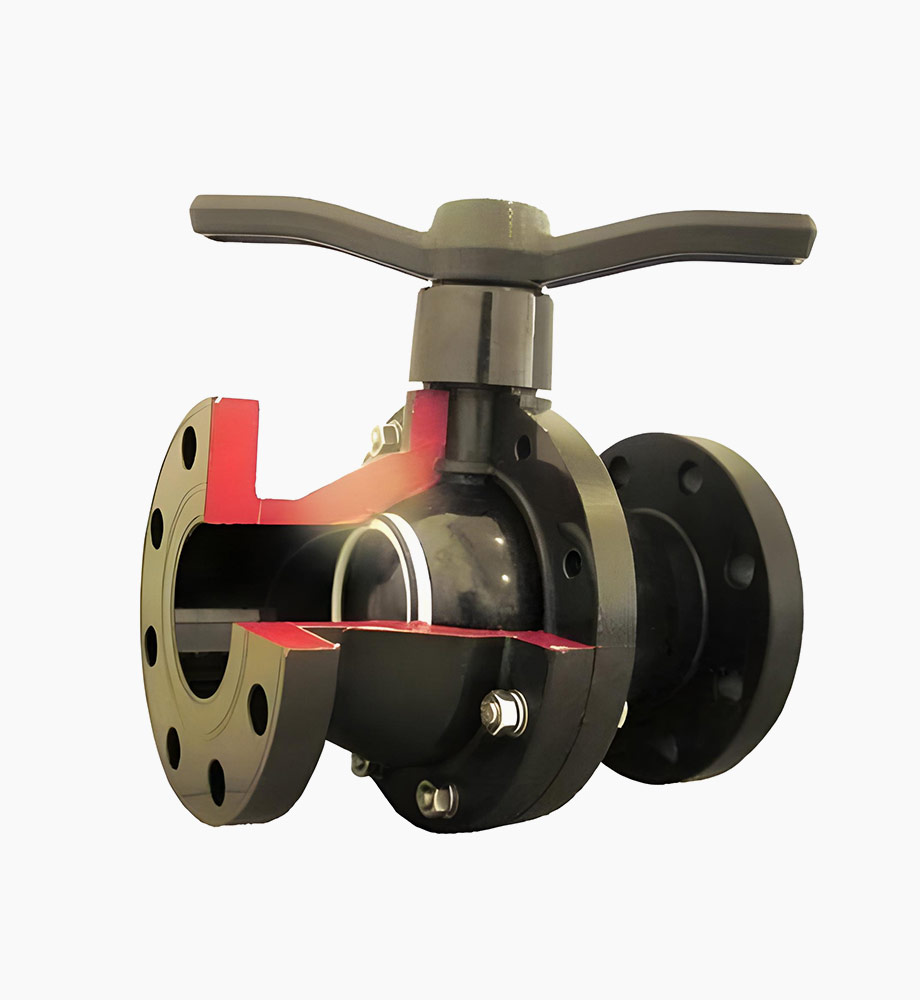Key Features
- FRP Composite Body: The valve body and movable element (disc or plug) are made of fiberglass-reinforced resin (polyester/vinylester/epoxy), offering corrosion resistance. (For ball valves, the ball is FRP; seats are PTFE or rubber.)
- Lightweight: An FRP valve can weigh 1/5th of a comparable steel valve, reducing support costs. For large butterfly valves, all-FRP bodies are possible up to 1–3 m diameter.
- Metal Seat Isolation: Only the elastic seat (EPDM, FKM) and optional stainless stem seals contact the fluid; all FRP and rubber parts are inert. This yields bubble-tight shutoff with negligible corrosion risk.
- Low Operating Torque: Machined, balanced FRP discs and smooth liners minimize friction. Many FRP butterfly valves achieve ANSI Class VI leak-tight closure.
Benefits
- Chemical Compatibility: FRP valves survive fluids that would quickly destroy metal valves (e.g. acids, bleaching agents, chlorine gas). They are also non-sparking, making them safer for flammable/corrosive service.
- Low Maintenance: Since the body won’t corrode, valve life is governed by the seat only. In many cases, the entire valve is replaced rather than repaired, but until then it remains dependable with minimal upkeep.
- Smooth Flow Path: The inherent smooth surface of FRP (often lined or molded) resists scale and biological growth, preserving full flow capacity over time.
- Integrated Actuation: FRP valves can be supplied with manual handwheels, gear operators, or pneumatic actuators, often with FRP or composite gears and housings for all-weather reliability.
Applications
FRP valves are found wherever FRP piping is used. Typical industries include chemical processing (e.g. acid pickling lines, salt/chlorine transfer), water and wastewater (chlorine bleach control, treatment chemicals), pulp & paper (bleach plant, caustic), pharmaceutical and biotech (pure water, corrosives), semiconductor (ultrapure chemistries) and mining (leachate circuits). They serve in both liquid and low-pressure gas service, and are common on scrubber systems and flue-gas handling. Large FRP butterfly valves (1–3 m) are used in cooling towers, effluent diversion, and ventilation dampers because of their lightweight and corrosion-proof nature.
Technical Specifications
- Valve Types: FRP ball valves and plug valves often have FRP bodies with PTFE/Viton seats. FRP butterfly valves have a bonded FRP body and disc, stainless shafts, and elastomer seats.
- Sizes & Ratings: Typically ASME class 150/PN16 or class 300/PN25, in sizes from 1″ up to several feet, matching FRP flange standards. Pressure ratings depend on design (e.g. 150–300 psi for butterfly).
- Materials: Common body resins: vinyl ester, epoxy phenolic. Seat materials: EPDM, FKM, PTFE. Stem bushings and gears may be ceramic or glass-filled PTFE.
- Connections: Usually grooved or flanged ends to mate with FRP pipe flanges. Some are wafer-style for insertion between two flanges.
- Standards: Manufacturing can meet MSS-SP or ANSI valve specs for face-to-face dimensions and test procedures. Burst or seat-leakage tests are performed like metal valves.
Unique Selling Points (USPs)
- All-FRP Wet-End: With the exception of the stem, an FRP valve’s entire fluid path can be fiberglass or rubber, leaving virtually no metal to corrode. This means the valve will not contaminate sensitive fluids with rust or ions.
- Lightweight Control: FRP butterfly and ball valves can be gear-operated with much smaller actuators/supporting structures than steel valves. This is critical in large piping where metal valve weight becomes a handling issue.
- Bubble-Tight Shutoff: Many FRP valves meet ANSI Class VI (zero leakage) due to precision molding and resilient seats. They perform reliably for years in corrosive service without packing adjustments.
- Fire Retardant Options: FRP valves can be made with fire-retardant resin systems and coatings, which is difficult with thermoplastic valves.
- High Safety: Non-conductive bodies eliminate electrical hazards in high-voltage environments. They also won’t spark, adding safety in explosive or flammable fluid service.

